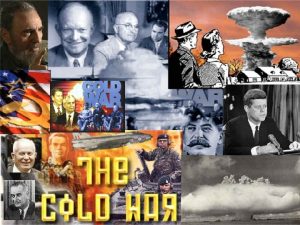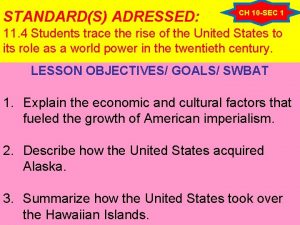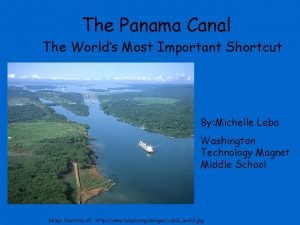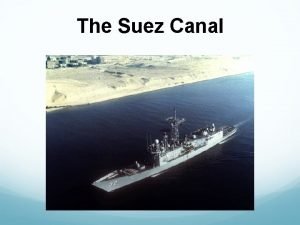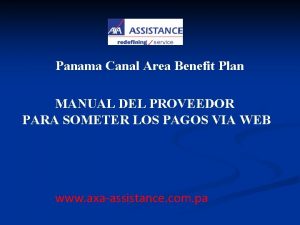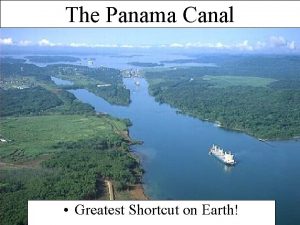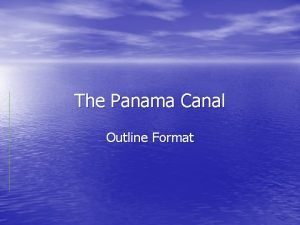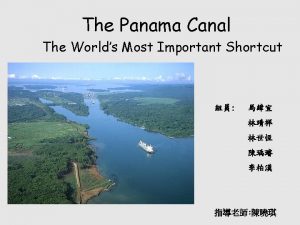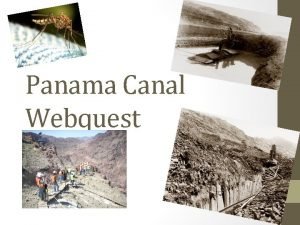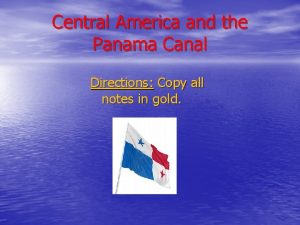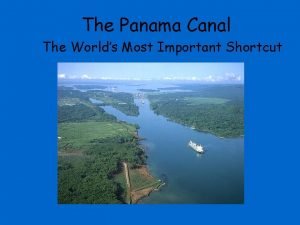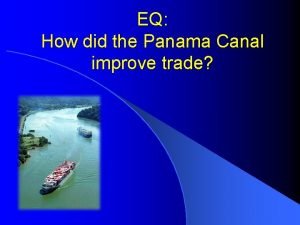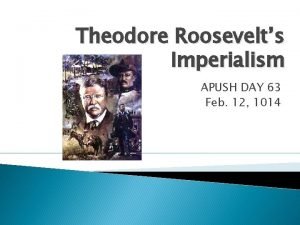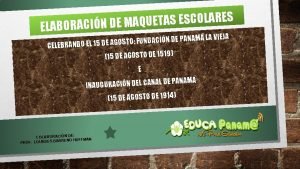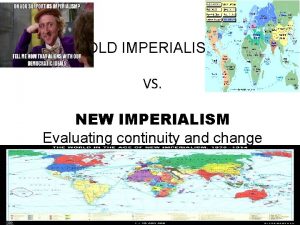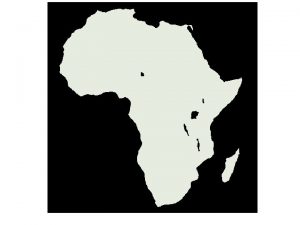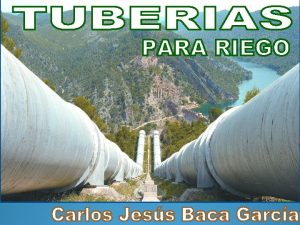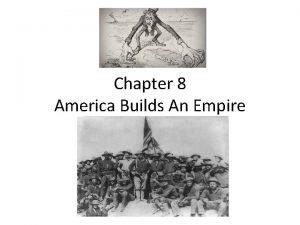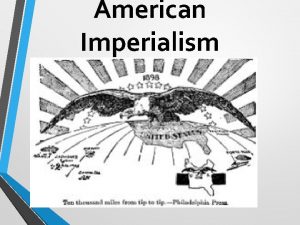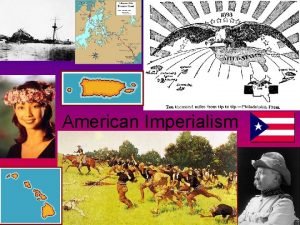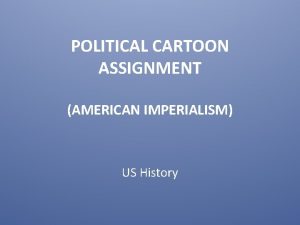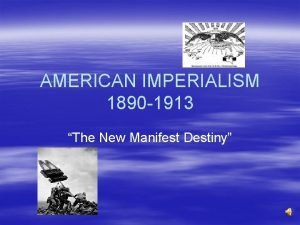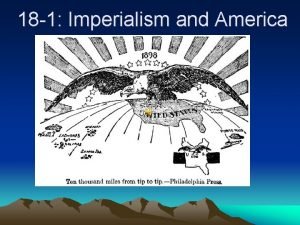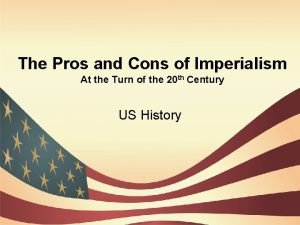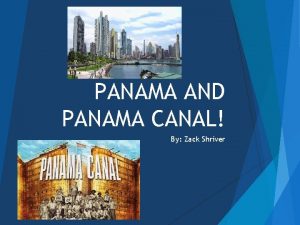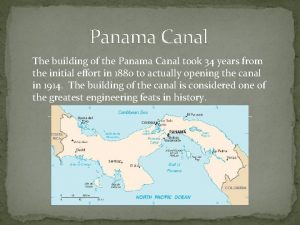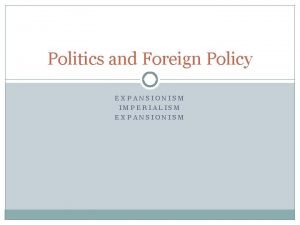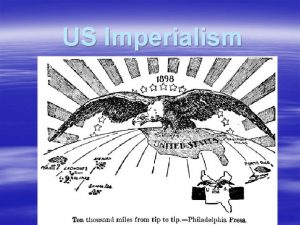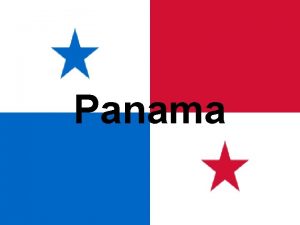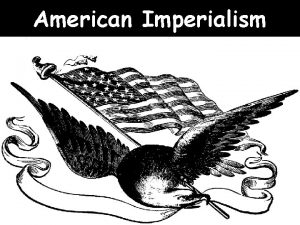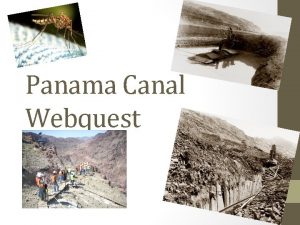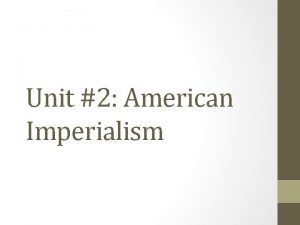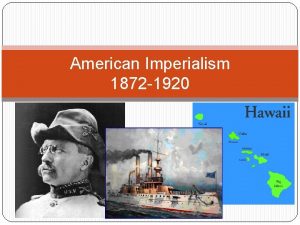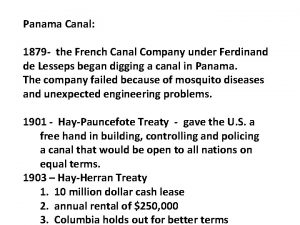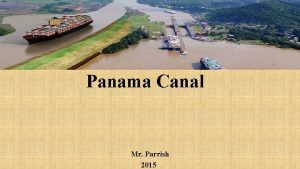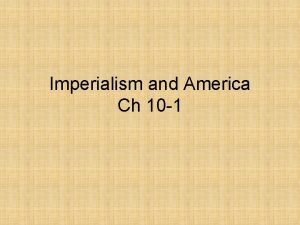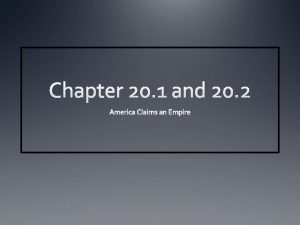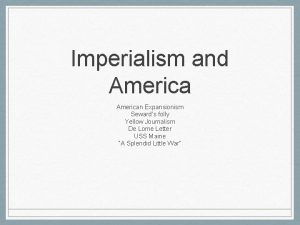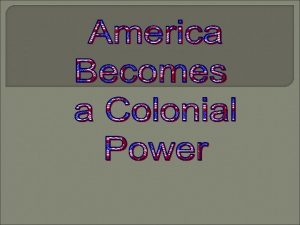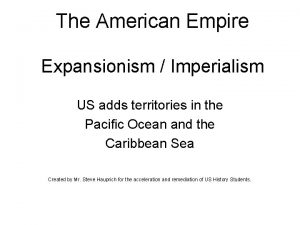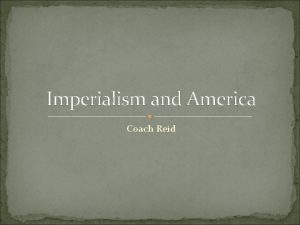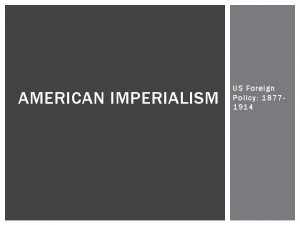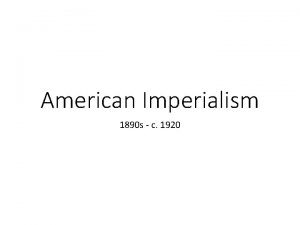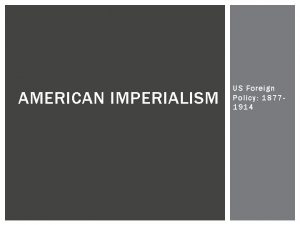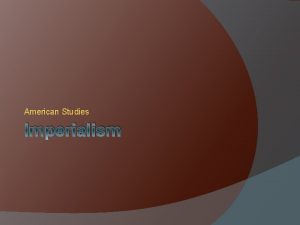American Expansionism the Panama Canal Imperialism Defined as





























- Slides: 29

American Expansionism & the Panama Canal

Imperialism Defined as the domination of one country by another. European imperialists had seized vast territories in Africa and Asia. Many Americans felt that the moment was now right for U. S. imperialism. With the closing of the American frontier, the nation continued its expansion overseas. http: //asms. k 12. ar. us/classes/humanities/worldstud/97 -98/imper/Philippines/USA. HTM

Some advocates argued that since the United States was now an industrial power, colonies could provide needed raw materials for American factories and a guaranteed market of U. S. manufacturers. http: //www. jackdaw. com/pc-282 -65 -american-imperialism. aspx

Others saw colonial expansion as a way of showing that the United States was a great nation, arguing the country should grab a few colonies before nothing was left. Inspired by Manifest Destiny. http: //en. dcdatabaseproject. com/Image: Uncle_Sam_BNW_1. jpg

In particular, these voices favored American control of the Caribbean, building a canal through Panama, and the acquisition of islands in the Pacific as coaling stations for ships trading with Asia. http: //www. canalmuseum. com/

Opponents felt that imperialism violated America’s democratic principles. They reminded citizens that America was also once a colony and had fought a war with Great Britain to break the chains of imperialism. http: //upload. wikimedia. org/wikipedia/commons/d/de/Washington_Crossing_the_Delaware. png

During these Imperialist years, the United States acquired a colonial empire in the Pacific consisting of the Philippines, Guam, Hawaii, Samoa, and Midway. http: //www. historywiz. com/laimp-mm. htm

Formerly part of the Spanish empire, the Philippines came under U. S. rule after the Spanish-American War. Filipino rebels had expected independence and fought against U. S. control until they were defeated in 1902. Filipino Rebels http: //asms. k 12. ar. us/classes/humanities/worldstud/97 -98/imper/Philippines/USA. HTM http: //people. bu. edu/juliango/publications_files/Go. Fostercover%2520 copy. jfif

In the mid-19 th century, American settlers built sugar and pineapple plantations on Hawaii. These settlers overthrew the Hawaiian queen in 1893. After the outbreak of the Spanish-American War, Congress voted in favor of the annexation of Hawaii in 1898. http: //harwich. edu/depts/history/pp/imperialism/sld 006. htm

Gunship Diplomacy Trade with Asians begins in 1853, the United States had forced open an isolationist Japan to Western trade and influence when Commodore Matthew Perry landed there with American navy. http: //en. wikipedia. org/wiki/Image: Perry. Fleet. jpg

The U. S. announced the Open Door Policy, favoring equal trading rights for all foreign nations in China. In 1900, the Boxer Rebellion threatened foreigners in China. An international army, with U. S. participation, crushed the rebellion, but Americans opposed any attempt by other nations to use the rebellion to dismember China. Boxer Rebel http: //en. wikipedia. org/wiki/Image: Boxer 1900. jpg

Panama Canal Military importance: Naval strategists believed that the United States needed a large navy and a canal through Central America to establish itself as a world sea power. http: //www. history. navy. mil/photos/images/h 73000/h 73411. jpg

The Panama Canal

President Roosevelt took steps to build a canal that would allow ships to cross between the Atlantic and Pacific Oceans without circling South America. The Isthmus of Panama, the narrowest point in Central America, was a natural place to build the canal, but posed may challenges. http: //harwich. edu/depts/history/pp/imperialism/sld 049. htm

Panama Canal – Roosevelt (Pres. in 1901) wants to build a canal across the Isthmus of Panama to shorten the sea route from New York to San Francisco by 5, 000 miles. – US Navy could also move quicker from coast to coast. – Panama controlled by Columbia • Columbia rejects Roosevelt’s offer of 10 million to build canal. • US encourages Panamanian revolution (1903), and gain independence with help from US Navy. • Construction begins on the Canal 1904.

When Panamanian rebels declared their independence from Columbia in 1903, Roosevelt sent U. S. warships to protect them. http: //www. panamacanalcountry. com/images/US%20 stamp%20 of%20 Ancon%20 crossing%20 Canal. jpg

In return for U. S. protection, the new government of Panama gave the United States control of the Panama Canal Zone, a ten-mile wide strip of land through the center of Panama. http: //www. smplanet. com/imperialism/joining. html

Natures Challenges and the Panama Canal • Tropical climate • Disease-carrying mosquitoes • Mountains http: //www. healthsystem. virginia. edu/internet/library/historical/medical_history/yellow_fever/assets/panama. jpg

• To prevent malaria and yellow fever, the U. S. Army cleaned up swamps where infected mosquitoes had bred. http: //yellowfever. lib. virginia. edu/reed/images/03 -NC. jpg http: //www. tea. state. tx. us/student. assessment/resources/online/2006/grade 11/ss/images/8 graphicaa. gif

They built a series of locks that raised shops to an artificial lake, across the central highland, and then lowered them back to sea level on the other side. http: //z. about. com/d/cruises/1/0/r/w/1/panama_canal 021. jpg

The Isthmus of Panama

The Locks of the Panama Canal

Miraflores Locks


It took the Army Corps of Engineers ten years to build the enormous locks and to remove millions of tons of earth to complete the canal. It was completed in 1914. http: //www. smplanet. com/imperialism/joining. html

In the early 20 th century, the U. S. government extended the Monroe Doctrine through the Roosevelt Corollary. http: //www. mexicolore. co. uk/uploadimages/169_02_2. jpg

In 1904, President Theodore Roosevelt declared that the U. S. would act as an “international police power” in Latin America. Rather than let European nations intervene to collect their debts, the U. S. would act for them. http: //history. ucsc. edu/history 25 b/4 -24 slides_files/slide 0010_image 058. jpg

The Roosevelt Corollary to the Monroe Doctrine was used to justify sending troops into Haiti, Nicaragua, Honduras and the Dominican Republic. In this way, the United States protected its interests in the Panama Canal. Later, President Wilson intervened in both the Caribbean region and Mexico. www. csub. edu/~gsantos/jpgs/img 0099. jpg

 Comunist map
Comunist map What 3 factors spurred american imperialism
What 3 factors spurred american imperialism Expansionism cold war
Expansionism cold war Panama shortcut map
Panama shortcut map Suez canal in asia map
Suez canal in asia map Axa assistance panama canal area benefit plan
Axa assistance panama canal area benefit plan Panama canal
Panama canal Panama canal outline
Panama canal outline Panama canal shortcut
Panama canal shortcut Canal
Canal Ecotourism acrostic
Ecotourism acrostic World shortcut panama canal
World shortcut panama canal Panama canal labeled on map
Panama canal labeled on map Roosevelt corollary apush
Roosevelt corollary apush Escolares maquetas del canal de panama
Escolares maquetas del canal de panama New imperialism vs old imperialism
New imperialism vs old imperialism Old imperialism motives
Old imperialism motives Formula de blasius
Formula de blasius What is the collection of well-defined objects
What is the collection of well-defined objects Chapter 8 american imperialism vocabulary
Chapter 8 american imperialism vocabulary American imperialism 1800s
American imperialism 1800s What three factors spurred american imperialism
What three factors spurred american imperialism American imperialism political cartoons explained
American imperialism political cartoons explained Russia wants alska
Russia wants alska Roots of american imperialism
Roots of american imperialism Message behind
Message behind American imperialism definition
American imperialism definition The roots of american imperialism 1. economic roots
The roots of american imperialism 1. economic roots Pros and cons of imperialism
Pros and cons of imperialism Trời xanh đây là của chúng ta thể thơ
Trời xanh đây là của chúng ta thể thơ
